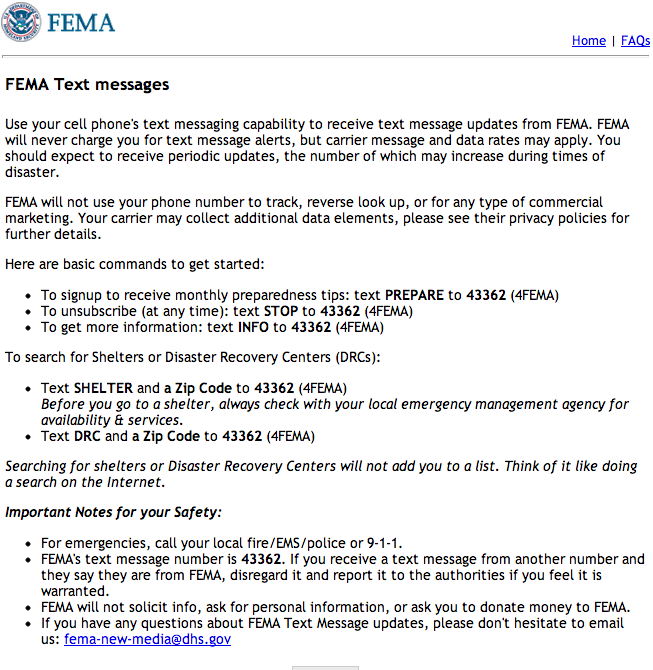FEMA uses SMS to help victims of Hurricane Sandy
The following is an official statement by the Federal Emergency Management Agency (FEMA) on using SMS for accessing disaster-related resources. A mobile friendly version of this statement is available here: http://m.fema.gov/text_messages.htm
Why FEMA chooses SMS
While it’s been widely reported that FEMA urged Americans to use text messaging instead of phone calls to communicate with friends and loved ones before, during and after Hurricane Sandy, the reasons may not be widely understood. The following is a discussion of why FEMA recommends SMS during large-scale emergencies and why the agency has invested in a comprehensive SMS communication program.
SMS is fast, efficient and reaches more people, more often
Depending on which study you look at, somewhere between 95% and 99% of all text messages are read within 15 minutes of receipt. When speed is a mission-critical requirement, nothing outperforms SMS. Especially when you consider that 91% of all Americans have their mobile phone with them 24 hours a day.
And because SMS is supported on nearly every mobile device–from the most feature-rich smartphone to the most basic flip phone–and at least 83% of all American adults own a mobile phone of some kind, it’s likely that SMS has the broadest potential reach of any form of mass communication.
Lastly, SMS is highly effective for communicating with people who are hearing impaired; a group that can be at greater risk during a disaster—particularly when communities rely on radio broadcasts, public address systems and civil defense sirens for early warning.
SMS has technical advantages too
Text messages are sent through an SMS wireless gateway and use different technology than voice messages. That’s why FEMA was encouraging people to send text updates to loved ones instead of flooding voice networks with calls. They wanted to reduce congestion on voice networks to make it easier for first responders and people with life threatening emergencies to communicate.
SMS is also a store-and-forward service, which means the recipient doesn’t have to be within range or even have their phone turned on at the moment a message is sent to eventually receive the message. This is critical in an emergency situation where power is out or wireless service is temporarily disrupted.
If it’s good enough for 300,000,000 people…
FEMA’s mandate is unlike that of any organization in the world. They’re responsible for helping more than 300 million people prepare for, deal with, and recover from the worst disasters imaginable. From hurricanes and earthquakes to nuclear power plant meltdowns and terrorist attacks, FEMA is expected to be there before, during and after any large-scale catastrophe America faces.
As we rapidly approach the moment in history when mobile phones outnumber people on Earth, and some of the same tools the U.S Government uses in its emergency response communications are available and affordable for any organization of any size, it’s worth acknowledging what a powerful force for good SMS can be. FEMA should be commended for recognizing this fact and building an effective program around it.
We rise and fall together
Our hearts and prayers go out to the victims and families of those affected by Hurricane Sandy. Please join us in supporting the recovery efforts by texting REDCROSS to 90999 to make a $10 contribution.
For more on the Red Cross text-to-donate program go to: http://www.redcross.org/support/donating-fundraising/donations/text-messaging



















